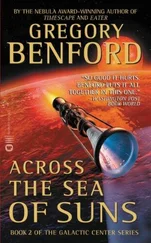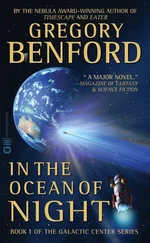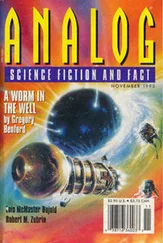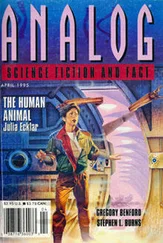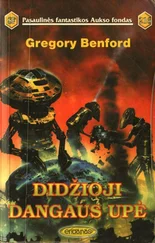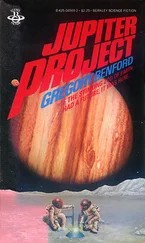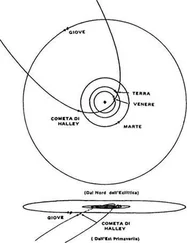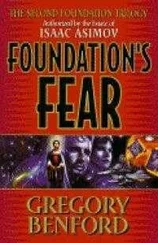“They don’t? Why not?”
“They interfere with each other. They make a crisscross network of local peaks and troughs. Where the peaks and troughs from the separate patterns coincide, they reinforce each other. But where the peaks of the first stone meet the troughs of the second, they cancel. The water doesn’t move.”
“Oh. All right, then.”
“What Wheeler and Feynmann showed was that the rest of the universe, when it’s hit by an advanced wave, acts like a whole lot of rocks dropped into that pond. The advanced wave goes back in time, makes all these other waves. They interfere with each other and the result is zero. Nothing.”
“Ah. In the end the advanced wave cancels itself out.”
Suddenly music blared over the Whim’s stereo: “An’ de Devil, he do de dance whump whump with Joan de Arc—”
Peterson shouted, “Turn that down, will you?”
The music faded. He leaned forward. “Very well. You’ve shown me why the advanced wave doesn’t work. Time communication is impossible.”
Markham grinned. “Every theory has a hidden assumption. The trouble with the Wheeler and Feynmann model was that all those jiggling electrons in the universe in the past might not send back just the right waives. For radio signals, they do. For tachyons they don’t. Wheeler and Feynmann didn’t know about tachyons; they weren’t even thought of until the middle ‘60s. Tachyons aren’t absorbed the right way. They don’t interact with matter the way radio waves do.”
“Why not?”
“There different kinds of particles. Some guys named Feinberg and Sudarshan imagined tachyons decades ago, but nobody could find them. Seemed too unlikely. They have imaginary mass, for one thing.”
“Imaginary mass?”
“Yes, but don’t take it too seriously.”
“Seems a serious difficulty.”
“Not really. The mass of these particles isn’t what we’d call an observable. That means we can’t bring a tachyon to rest, since it must always travel faster than light. So, if we can’t bring it to a stop in our lab, we can’t measure its mass at rest. The only definition of mass is what you can put on the scales and weigh—which you can’t do, if it’s moving. With tachyons, all you can measure is momentum—that is, impact.”
“You have a complaint about the food, sir? I am the manager.”
Peterson looked up to find a tall man in a conservative gray suit standing over their table, hands clasped behind him military style. “Yes, I did. Mostly I preferred not to eat it, in view of what it did to that lady a short while ago.”
“I do not know what the lady was eating, sir, but I should think your—”
“Well, I do, you see. It was certainly close enough to what my friend here ordered to make him uncomfortable.”
The manager bridled slightly at Peterson’s manner. He was sweating slightly and had a harried look. “I fail to see why a similar type of food should—”
“I can see it quite plainly. A pity you can’t.”
“I am afraid we shall have to charge you for—”
“Have you read the recent Home Office directives on imported meats? I had a hand in writing them.” Peterson gave the manager the full benefit of his assessing gaze. “I would say you probably get much of your imported meat from a local supplier, correct?”
“Well, of course, but—”
“Then you presumably know that there is a severe restriction on how long it can be kept before use?”
“Yes, I’m sure…” the manager began, but then hesitated when he saw the look on Peterson’s face. “Well, actually I haven’t read much of those lately because—”
“I think I would take more care in future.”
“I am not sure the lady actually ate any imported meat whatever—”
“I would look into it, if I were you.”
Abruptly the man lost some of his military bearing. Peterson looked at him with assurance.
“Well, I think we can forget the misunderstanding, sir, in light of—”
“Indeed.” Peterson nodded, dismissing him. He turned back to Markham. “You still haven’t got round the grandfather thing. If tachyons can carry a message back to the past, how do you avoid paradoxes?” Peterson did not mention that he had gone through a discussion with Paul Davies at King’s about this, but understood none of it. He was by no means assured that the ideas made any sense.
Markham grimaced. “It’s not easy to explain. The key was suspected decades ago, but nobody worked it out into a concrete physical theory. There’s even a sentence in the original Wheeler-Feynmann paper—’It is only required that the description should be logically self-consistent.’ By that they meant that our sense of the’ flow of time, always going in one direction, is a bias. The equations of physics don’t share our prejudice—they’re time-symmetric. The only standard we can impose on an experiment is whether it’s logically consistent.”
“But it’s certainly illogical that you can be alive even after you’ve knocked off your own grandfather. Killed him before he produced your father, I mean.”
“The problem is, we’re used to thinking of these things as though there was some sort of switch involved, that only had two settings. I mean, that your grandfather is either dead or he isn’t.”
“Well, that’s certainly true.”
Markham shook his head. “Not really. What if he’s wounded, but recovers? Then if he gets out of the hospital in time, he can meet your grandmother. It depends on your aim.”
“I don’t see—”
“Think about sending messages, instead of shotgunning grandfathers. Everybody assumes the receiver—back there in the past—can be attached to a switch, say. If a signal from the future comes in, the switch is programmed to turn off the transmitter— before the signal was sent. There’s the paradox.”
“Right.” Peterson leaned forward, finding himself engrossed despite his doubts. There was something he liked about the way scientists had of setting up problems as neat little thought experiments, making a clean and sure world. Social issues were always messier and less satisfying. Perhaps that was why they were seldom solved.
“Trouble is, there’s no switch that has two settings—on and off—with nothing in between.”
“Come now. What about the toggle I flip to turn on the lights?”
“Okay, so you flip it. There’s a time when that switch is hanging in between, neither off nor on.”
“I can make that a very short time.”
“Sure, but you can’t reduce it to zero. And also, there’s a certain impulse you have to give that switch to make it jump from off to on. In fact, it’s possible to hit the switch just hard enough to make it go halfway—try it. That must’ve happened to you sometime. The switch sticks, balanced halfway between.”
“All right, granted,” Peterson said impatiently. “But what’s the connection to tachyons? I mean, what’s new about all this?”
“What’s new is thinking of these events—sending and receiving—as related in a chain, a loop . Say, we send back an instruction saying, ‘Turn off the transmitter.’ Think of the switch moving over to ‘off.’ This event is like a wave moving from the past to the future. The transmitter is changing from ‘on’ to ‘off.’ Now, that—well, let’s call it a wave of information— moves forward in time. So the original signal doesn’t get sent”
“Right. Paradox.”
Markham smiled and held up a finger. He was enjoying this. “But wait! Think of all these times being in a kind of loop. Cause and effect mean nothing in this loop. There are only events . Now as the switch moves towards ‘off,’ information propagates forward into the future. Think of it as the transmitter getting weaker and weaker as that switch nears the ‘off’ position. Then the tachyon beam that transmitter is sending out gets weaker.”
Читать дальше

